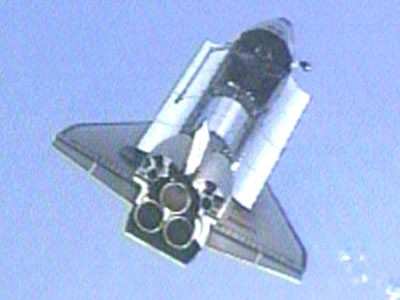NASA To Decide Tuesday On Adding A Second Extra Day To
Mission
What a team. On Monday, STS-122 and Expedition 16 crew members
worked together to attach the European Space Agency's Columbus
Laboratory to the International Space Station's Harmony module.

During STS-122's first spacewalk, Mission Specialists Rex
Walheim and Stanley Love bolted the Power and Data Grapple Fixture
(PDGF) to the Columbus module. The PDGF provided a grapple point
for the station's robotic arm. The spacewalkers installed power
cables on Columbus and reinstalled the debris shields they had
removed earlier.
STS-122 Mission Specialists Leland Melvin and Daniel Tani, along
with Expedition 16 Flight Engineer Leopold Eyharts, used the
orbital outpost's robotic arm to guide Columbus into position for
final installation. The $2 billion Columbus lab was officially
attached to the right side of the Harmony module at 1644 EST.
"The European Columbus module is officially part of the
International Space Station," said Eyharts after the installation,
reports Agence-France Presse.

The delivery and installation of Columbus represents a milestone
in Europe's history in space, and is the first addition to the
"international" station that didn't come from the US or Russia. It
won't be the last -- Japan's Kibo module is slated for delivery in
March.
Meanwhile, the spacewalkers completed some work to prepare for
the replacement of the Nitrogen Tank Assembly (NTA), part of the
station's thermal control system, on the P1 truss. They also
installed micrometeroid debris shields to the module's
exterior.
The seven-hour, 58-minute excursion concluded at 1711 EST.
As ANN reported, Love stood
in on the spacewalk in the place of German astronaut Hans Schlegel,
who fell victim to an as-yet-unknown malady this weekend. NASA
remains mum on the nature of Schlegel's ailment, citing privacy
concerns -- but for the moment, he is scheduled to join Walheim on
STS-122's second spacewalk, slated to being Wednesday morning.
On Sunday, ESA spokesman Markus Bauer said Schlegel, 56,
appeared to have recovered, and was doing "very well. We are
assuming that he will take part in the second spacewalk," the
spokesman added. (We'll note here it's not uncommon for
first-time spacefarers to suffer from motion sickness during their
first few days in orbit -- Ed.)
Walheim and Schlegel will complete the replacement of the NTA
and install trunnion covers on Columbus during the second
spacewalk.

In related news, NASA announced Monday the shuttle Atlantis'
heat shield appears to be in perfect condition, with the critical
nose and wing leading edges earning a clean bill of health. The
agency is still determining whether to undergo a spacewalk to tack
down a small heat blanket section on the orbiter's right Orbital
Maneuvering System (OMS) pod.
STS-122 chief John Shannon said the agency will determine
Tuesday whether to add a second extra day in orbit, presumably to
allow for a spacewalk to repair the blanket. Atlantis crewmembers
have already taken steps to conserve energy, to allow enough juice
to keep Atlantis in orbit for the extra day.
 ANN's Daily Aero-Linx (05.02.24)
ANN's Daily Aero-Linx (05.02.24) ANN's Daily Aero-Term (05.02.24): Touchdown Zone Lighting
ANN's Daily Aero-Term (05.02.24): Touchdown Zone Lighting Aero-News: Quote of the Day (05.02.24)
Aero-News: Quote of the Day (05.02.24) ANN FAQ: Contributing To Aero-TV
ANN FAQ: Contributing To Aero-TV NTSB Final Report: Cirrus Design Corp SR20
NTSB Final Report: Cirrus Design Corp SR20





